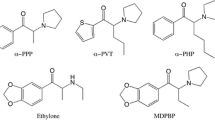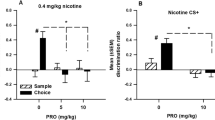Abstract
The recognition of an unfamiliar juvenile rat by an adult rat has been shown to imply short-term memory processes. In this study the effect of various psychotropic drugs on this investigatory behaviour was examined. The procedure was as follows: an unfamiliar juvenile rat was placed in the home cage of an adult rat for 5 min. The time spent by the adult rat in investigating the juvenile was recorded. The adult rat was then immediately treated with vehicle or test compounds, and was again exposed for 5 min to the same juvenile 2 h later. At this time point vehicle-treated rats no longer recognized the juvenile rat, i.e. the time of investigation was similar to that observed during the first presentation. Arecoline (1 and 3 mg/kg IP), physostigmine (0.05 and 0.1 mg/kg SC), RS86 (0.5 mg/IP) and nicotine (0.125 and 0.5 mg/kg IP) reduced in a dose-dependent fashion the time spent in investigating the juvenile during the second exposure. This result cannot be attributed to nonspecific effects, since it was not observed when a different juvenile was used for the second exposure. The effect of arecoline was reversed by scopolamine, but not by methylscopolamine. Aniracetam reduced investigatory behaviour at the dose of 50 mg/kg IP. FG 7142 (5 mg/kg IP) and β-CCM (0.4 mg/kg IP) were also active and their effect was reversed by Ro 15-1788. dl-Amphetamine (0.5 and 1 mg/kg IP), nomifensine (1.25–10 mg/kg IP) and strychnine (0.25 and 0.5 mg/kg IP) were ineffective or reduced this behaviour unspecifically. Social recognition may therefore represent a useful and simple test to detect compounds which enhance short-term, olfactory, memory and to assess in the same animals the specificity of this activity.
Similar content being viewed by others
References
Aggleton JP, Hunt PR, Rawlins JNP (1986) The effects of hippocampal lesions upon spatial and non-spatial tests of working memory. Behav Brain Res 19:133–146
Alpern HP, Jackson SJ (1978) Stimulants and depressants: drug effects on memory. In: Lipton MA, Di Mascio A, Killiam KF (eds) Psychopharmacology: a generation of progress. Raven Press, New York, pp 663–675
Bartus RT (1979) Physostigmine and recent memory: effects in young and aged nonhuman primates. Science 206:1087–1089
Bartus RT, Johnson HR (1976) Short-term memory in the rhesus monkey: disruption from the anticholinergic scopolamine. Pharmacol Biochem Behav 5:39–46
Beninger RJ, Jhamandas K, Boegman RJ, El-Defrawy SR (1985) Effects of scopolamine and unilateral lesions of the basal forebrain on T-maze spatial discrimination and alternation in rats. Pharmacol Biochem Behav 24:1353–1360
Carew TJ (1970) Do passive avoidance tasks permit assessment of retrograde amnesia in rats? J Comp Physiol Psychol 72:267–271
Carr WJ, Yee L, Gable D, Marasco E (1976) Olfactory recognition of conspecifics by domestic Norway rats. J Comp Physiol Psychol 90:821–828
Cumin R, Bandle EF, Gamzu E, Haefely WE (1982) Effects of the novel compound aniracetam (ro 13-5057) upon impaired learning and memory in rodents. Psychopharmacology 78:104–111
Dantzer R, Bluthe RM, Koob GF, Le Moal M (1987) Modulation of social memory in male rats by neurohypophyseal peptides. Psychopharmacology 91:363–368
Dunnett SB (1985) Comparative effects of cholinergic drugs and lesions of nucleus basalis or fimbria-fornix on delayed matching in rats. Psychopharmacology 87:357–363
Ennaceur A, Delacour J (1987) Effect of combined or separate administration of piracetam and choline on learning and memory in the rat. Psychopharmacology 92:58–67
File SE (1976) Are central cholinergic paths involved in habituation of exploration and distraction? Pharmacol Biochem Behav 4:695–702
File SE (1980) The use of social interaction as a method for detecting anxiolytic activity of chlordiazepoxide-like drugs. J Neurosci Methods 2:219–238
Gerhards HJ, Carenzi A, Costa E (1974) Effect of nomifensine on motor activity, dopamine turnover rate and cyclic 3′,5′-adenosine monophosphate concentrations of rat striatum. Naunyn-Schmiedeberg's Arch Pharmacol 286:49–63
Gibbs ME, De Vaus J, NG KT (1986) Effect of stress-related hormones on short term memory. Behav Brain Res 19:1–6
Gold PE, Van Buskirk R, Haycock JW (1977) Effects of postraining epinephrine injections on retention of avoidance training in mice. Behav Biol 20:197–204
Greenough WT, McGauch JL (1965) The effects of strychnine sulfate on learning as a function of time of administration. Psychopharmacologia 8:290–294
Haroutunian V, Barnes E, Davis KL (1985) Cholinergic modulation of memory in rats. Psychopharmacology 87:266–271
Heise GA (1987) Facilitation of memory and cognition by drugs. TIPS 8:65–69
Hoffmann I (1982) Pharmacology of nomifensine. Int Pharmacopsychiatry [Suppl 1] 17:4–20
Hunkeler W, Mohler H, Pieri L, Pole P, Bonetti EP, Cumin R, Schaffner R, Haefely W (1981) Selective antagonists of benzodiazepines. Nature 290:514–516
Leccese AP, Grant DS (1980) Postrial injections of strychnine sulfate: Facilitation of consolidation or retrieval? Anim Learn Behav 8:258–264
Miczek KA, Krsiak M (1979) Drug effects on agonistic behavior. In: Thompson T, Dews PB (eds) Advances in behavioral pharmacology. Academic Press, New York, pp 88–162
Morris R (1984) Developments of the water-maze procedure for studying spatial learning in the rat. J Neurosci Methods 11:46–60
Palacios JM, Bollinger G, Closse A, Enz A, Gmelin G, Malanowski J (1986) The pharmacological assessment of RS 86 (2-ethyl-8-methyl-2,8-diazaspiro-(4,5) decan-1,3-dion hydrobromide): a potent, specific muscarinic acetylcholine receptor agonist. Eur J Pharmacol 125:45–62
Platel A, Porsolt RD (1982) Habituation of exploratory activity in mice: a screening test for memory enhancing drugs. Psychopharmacology 78:346–352
Quatermain D (1982) Catecholamine involvement in memory retrieval processes. In: Morrison AR, Strick PL (eds) Changing concepts of the nervous system. Academic Press, New York, pp 667–679
Sahgal A (1986) Effects of vasopressin, des-glycinamide vasopressin and amphetamine on a combined passive and active avoidance task. Psychopharmacology 90:494–498
Sawyer TF, Hengehold AK, Perez WA (1984) Chemosensory and hormonal mediation of social memory in male rats. Behav Neurosci 98:908–913
Soubrié P, Simon P, Boissier JR (1976) Amnésie induite chez le rat par les benzodiazépines lors d'une situation ne faisant pas intervenir de composante nociceptive. CR Acad Sci (Paris) 283:203–205
Squire LR, Davis HP (1981) The pharmacology of memory: a neurobiological perspective. Annu Rev Pharmacol Toxicol 21:323–356
Squire LR, Zola-Morgan S (1988) Memory: brain system and behaviour. TINS 11:170–175
Thor DH, Holloway WR (1982) Social memory of the male laboratory rat. J Comp Physiol Psychol 96:1000–1006
Valzelli L (1973) Activity of benzodiazepines on aggressive behavior in rats and mice. In: Garattini S, Mussini E, Randall LO (eds) The benzodiazepines. Raven Press, New York, pp 405–417
Venault P, Chapouthier G, Prado de Carvalho L, Simiand J, Morre M, Dodd RH, Rossier J (1986) Benzodiazepine impairs and β-carboline enhances performance in learning and memory tasks. Nature 321:864–866
Warburton DM, Wesnes K (1984) Drugs as research tools in psychology: cholinergic drugs and information processing. Neuropsychobiology 11:121–132
Author information
Authors and Affiliations
Rights and permissions
About this article
Cite this article
Perio, A., Terranova, J.P., Worms, P. et al. Specific modulation of social memory in rats by cholinomimetic and nootropic drugs, by benzodiazepine inverse agonists, but not by psychostimulants. Psychopharmacology 97, 262–268 (1989). https://doi.org/10.1007/BF00442261
Received:
Accepted:
Issue Date:
DOI: https://doi.org/10.1007/BF00442261




